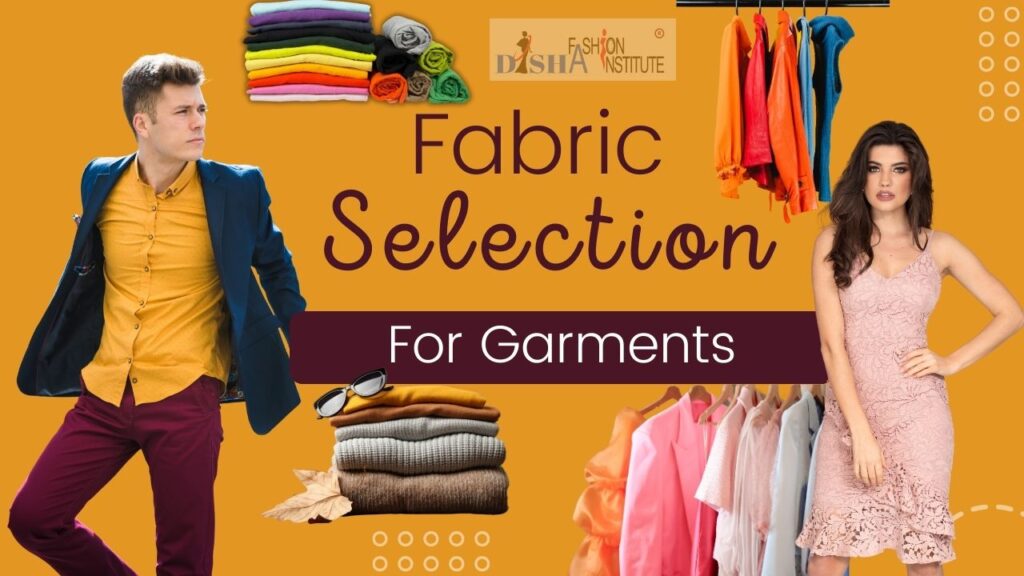The selection of fabric plays a vital role in the apparel industry, directly impacting the final product’s comfort, durability, and overall appearance. Whether working on a sewing project, managing a manufacturing company, or simply purchasing fabric for yourself or a loved one, choosing the appropriate fabric for garments is of utmost importance. With many fabric options available, both natural and synthetic, it can be overwhelming to determine the ideal choice for a specific garment.
Table of Contents
This article will emphasize the significance of fabric selection and provide guidelines for choosing the right fabric based on various garment types, seasons, and purposes. Whether you’re looking for fabrics for tops, bottoms, dresses, outerwear, or activewear, understanding the characteristics and qualities of different fabrics will enable you to make well-informed decisions and create stylish and functional garments.
To assist you in selecting the perfect fabric, we will guide you through some key considerations to remember when visiting fabric shops for your clothing projects.
#1 Fabric Selection Based on Garment Type
The garment type holds immense significance when selecting the perfect fabric for clothing projects or manufacturing endeavours. With different garments entailing unique requirements, factors like drape, stretch, durability, and breathability become pivotal and vary according to the garment type. Imagine a flowy dress gracefully adorned in lightweight and fluid fabrics like chiffon or a tailored suit exuding elegance through structured and wrinkle-resistant materials such as chambray. You unlock optimal performance and breathtaking aesthetics by meticulously matching the fabric to the specific garment type.
Tops/Shirts
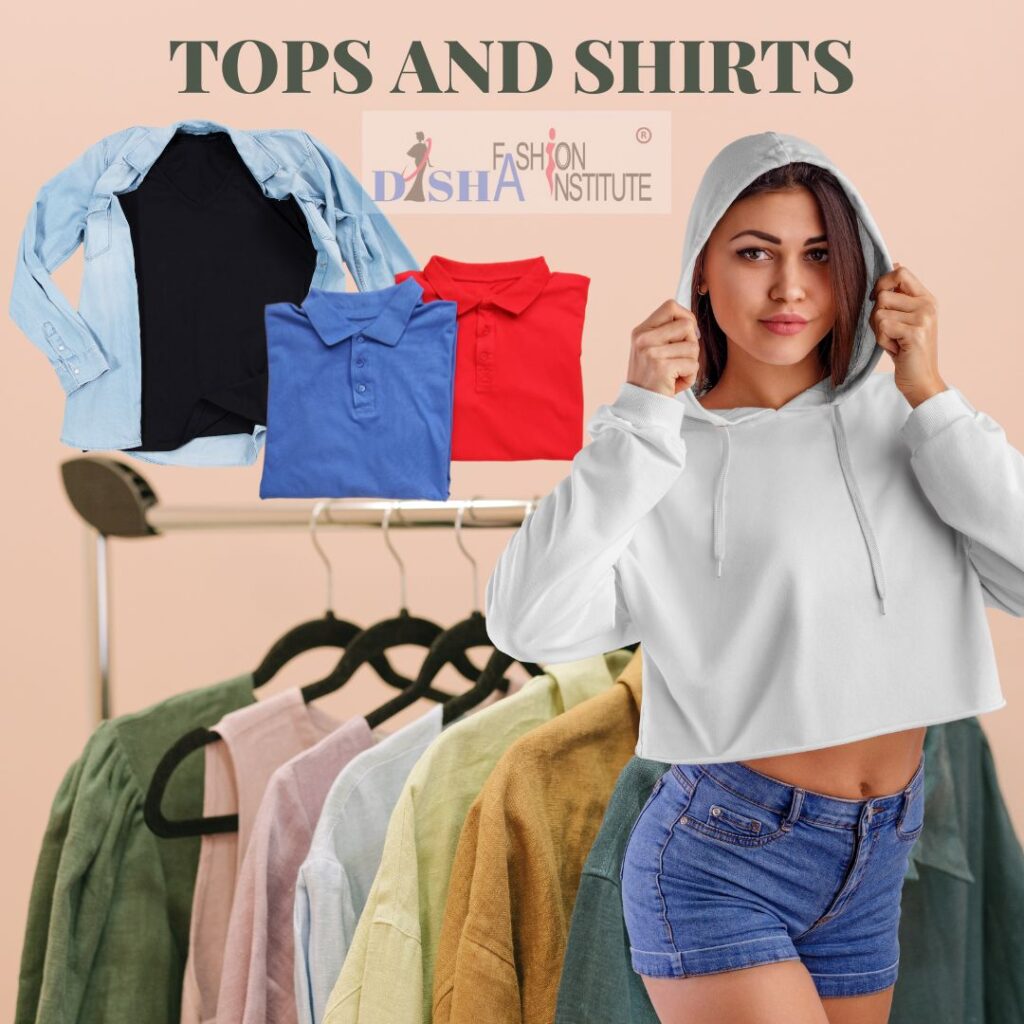
- Cotton and Linen take centre stage as the go-to fabrics for producing stunning tops and shirts. Renowned for their breathability, softness, and comfort, these fabrics never fail to impress.
- Cotton offers a range of weights, including lightweight voile or poplin for breezy summer tops or heavier flannel for chilly seasons.
- On the other hand, Linen shirts exude a relaxed and casual vibe.
- For those seeking elegance and luxury, Silk emerges as a prime choice, often adorning formal blouses and special occasion tops. Step into the limitless possibilities with these exquisite fabric options for your wardrobe essentials.
Bottoms/Pants

- Denim: A timeless choice for jeans and casual pants, renowned for its durability and versatility.
- Corduroy: A textured fabric that adds visual interest and warmth to pants and skirts, commonly embraced in fall and winter garments.
- Wool: A natural fibre offering insulation, warmth, and a sophisticated look, frequently used for tailored trousers or dress pants, especially in colder climates.
- Stretch Fabrics: Incorporating elastane or spandex blends in pants enhances comfort and flexibility, allowing for better movement and a more flattering fit.
- Additional Cotton Fabrics: Chambray, poplin, and linen also play a role in crafting casual trousers for the summer seasons, contributing to a lightweight and relaxed feel.
Dresses/Skirts
The fabric selection for dresses and skirts plays a significant role in achieving the desired silhouette and style.

- Chiffon, georgette, and organza are the lightweight and sheer fabric that creates flowy, ethereal dresses and skirts. It is commonly used for summer or formal occasion wear due to its delicate appearance and breathability.
- Silk, Satin are glossy and smooth fabric that adds elegance to dresses and skirts. It is often used for evening wear or formal occasions due to its luxurious sheen.
- Jersey knit fabrics are comfortable, stretchy, and have good drapes. They are commonly used for casual or body-hugging dresses.
- Taffeta is a crisp fabric that is often used for structured dresses or ball gown-style skirts, providing volume and shape to the garment.
#2 Importance of Fabric Weight in Fabric Selection
Regarding fabric selection, weight is a crucial factor influencing the garment’s overall look, feel, and functionality.
What is GSM?
GSM, an acronym for Grams per Square Meter, is the metric measurement of the weight of a fabric. It quantifies the weight of a square meter of fabric, regardless of its width. This measurement allows us to compare the weights of different types of fabrics in a standard way. Higher GSM indicates a heavier and denser fabric, while lower GSM signifies a lighter fabric.
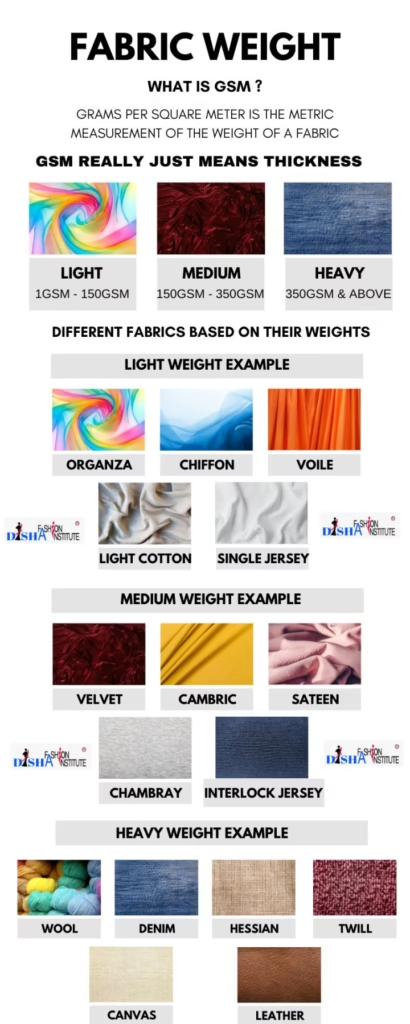
Classifications Based on Weight
Fabric weights are typically categorized into light, medium, and heavy.
Lightweight Fabrics (under 150 GSM): Lightweight fabrics, such as chiffon, voile, light cotton, and organza, usually have a GSM under 150. They are breathable, smooth, and perfect for creating delicate clothing items. These fabrics are ideal for summer, as they are airy and keep the wearer cool in hot weather.
Medium Weight Fabrics (150-350 GSM): Falling in the mid-range of fabric weights, these fabrics include denim, gabardine, and flannel. They balance durability and breathability, making them suitable for all-season wear.
Heavyweight Fabrics (over 350 GSM): Fabrics like canvas, wool, and leather fall into this category. They are durable, offer high insulation, and are excellent for outerwear or winter clothing. Although these fabrics are less breathable, they provide warmth in colder seasons.
Seasonal Suitability of Fabrics
As indicated, the weight of the fabric significantly influences its suitability for different seasons.
Summer: Lightweight fabrics, with their high breathability and cooling effect, are the go-to for summer clothing. They offer comfort in hot, humid weather conditions.
Spring/Autumn: Medium-weight fabrics balance breathability and insulation, making them apt for the transitional weather of spring and autumn.
Winter: Heavyweight fabrics, due to their high insulation properties, are perfect for cold winter seasons. They help to retain body heat, keeping the wearer warm in low temperatures.
By carefully selecting the appropriate fabric weight, you ensure the desired aesthetic and performance of the final product. Whether you aim for flowing elegance or structured sophistication, understanding the impact of fabric weight paves the way for exceptional creations that look and feel remarkable.
#3 Roles of Fabric Selection in the Magic of Fabric Drape
The draping quality is pivotal when choosing the fabric as it determines how it elegantly hangs and gracefully falls on the body. A fabric with a good drape creates fluid and flowing movements, enhancing the overall look and comfort of the garment. It can accentuate or detract from the desired silhouette and style.
Lightweight fabrics, such as chiffon, are renowned for their exceptional drape. They effortlessly create ethereal and captivating movements, lending an air of grace and delicacy to any design. On the other hand, stiffer fabrics have less inherent drape, offering a more structured and sculpted appearance. Choosing a fabric with the right drape is vital to achieving the desired aesthetic and ensuring the garment beautifully embraces the wearer.
Remember, fabric drape is the key to unlocking the mesmerizing allure of your creations, infusing them with a sense of motion and flow that captures the imagination. Embrace the transformative power of drape and watch your garments come alive, mesmerizing all who encounter them.
#4 Fabric Selection | The Ultimate Guide to Comfort
When choosing fabric, comfort takes center stage as the paramount consideration. The wearer’s comfort and skin sensitivity are pivotal in determining whether a garment will be embraced or rejected. The comfort of a garment is influenced by various factors, including breathability, softness, and its ability to regulate body temperature.
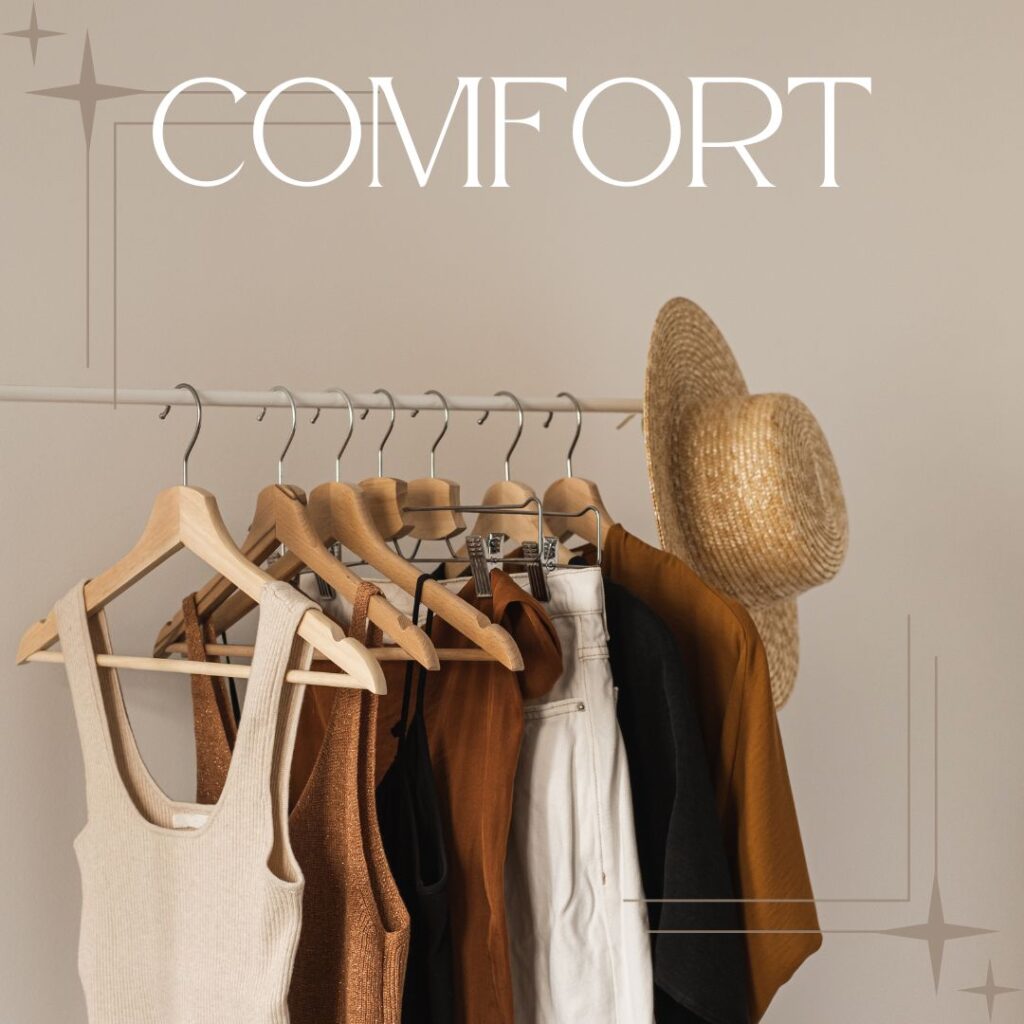
Breathability: The fabric’s breathability is crucial in ensuring optimal comfort. Fabrics like cotton excel in this area, as they possess excellent breathability properties. The natural fibers allow air circulation, preventing overheating and promoting a cool and comfortable wearing experience. Cotton is popular for tops and shirts, providing a soft and breathable feel against the skin.
Softness: The softness of the fabric enhances the overall comfort of the garment. Fabrics like cotton, known for their inherent softness, offer a gentle touch and a cozy sensation against the skin. The smooth texture contributes to a comfortable wearing experience, making it a favored choice for various types of clothing.
Body Temperature Regulation: The fabric’s ability to regulate body temperature is crucial for maintaining comfort throughout different seasons. Linen, for example, shines in this aspect. Its lightweight nature and exceptional moisture-wicking properties make it ideal for summer garments. Linen allows the body to breathe, ensuring a fresh and comfortable feel even in hot and humid conditions.
By considering the comfort factor in fabric selection, you ensure that the chosen fabric aligns harmoniously with the intended use and season of the garment. The fabric’s breathability, softness, and body temperature regulation provide an unparalleled comfort experience, enticing wearers to embrace and adore your creations. Elevate your fabric selection and immerse your audience in ultimate comfort and bliss.
#5 Style and Aesthetics: Enhancing Your Fabric Selection
Fabrics are pivotal in shaping a garment’s visual appeal and style. Each fabric has unique characteristics contributing to the design’s overall aesthetic and desired look.
Silk: Renowned for its luxurious and opulent appearance, silk reigns supreme in the world of high-end fashion. It’s lustrous sheen and smooth texture exude elegance, making it a favored choice for formal and special occasion dresses. The graceful silk drape enhances the garment’s movement, adding a touch of sophistication to any ensemble.
Chiffon: Delicate and lightweight, chiffon is a fabric that effortlessly embodies a sense of ethereal beauty. Its flowing nature creates a soft and romantic aesthetic, making it a popular choice for dresses and skirts. Chiffon brings an air of grace and femininity to designs, enchanting the wearer and those around them.
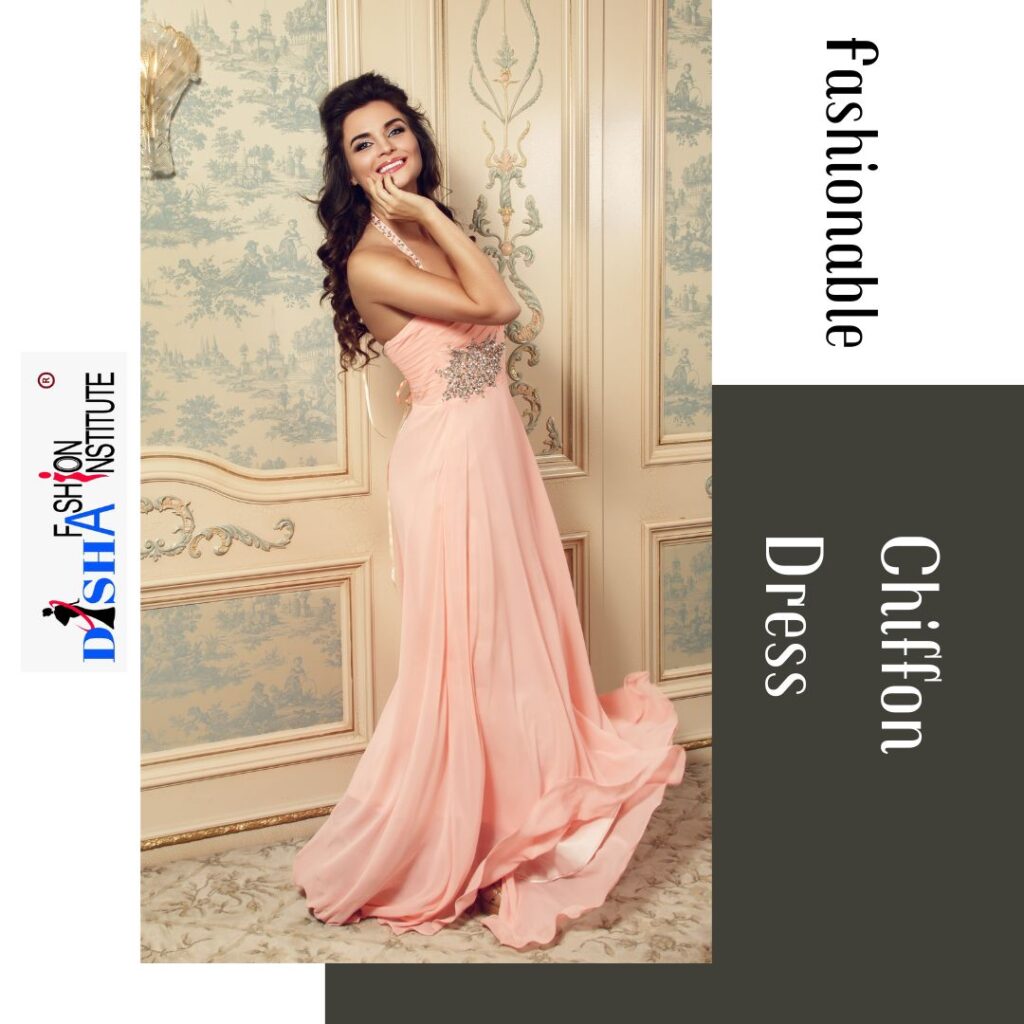
The choice of fabric is a powerful tool in expressing the desired style and achieving the desired aesthetic of a garment. Whether it’s the luxurious allure of silk or the dreamy elegance of chiffon, selecting the right fabric sets the stage for creating captivating designs that captivate the senses. Let your fabric choice be the brush with which you paint a masterpiece of style and aesthetics.
#6 Durability and Strength: Elevating Your Fabric Selection
When it comes to garments that face frequent wear and tear, the durability and strength of the fabric play a pivotal role. By carefully choosing fabrics that can withstand the demands of everyday use, you ensure longevity and resistance to wear, extending the lifespan of your creations.
- Denim: Renowned for its exceptional durability, denim takes the spotlight as the go-to fabric for jeans and casual pants. Its tightly woven construction and robust fibers make it highly resistant to abrasion and tearing. Denim effortlessly withstands the rigors of daily wear, providing a reliable and long-lasting choice for workers.
- Wool: With its inherent strength and resilience, wool emerges as a reliable fabric for winter outerwear. Wool fibers possess natural elasticity and durability, allowing them to bounce back and withstand harsh weather conditions. Wool garments offer excellent insulation and protection, making them suitable for confidently facing the elements.
- Canvas: Canvas is a sturdy and durable fabric commonly used for heavy-duty applications. It is often employed in producing outdoor gear, such as backpacks, tents, and sturdy workwear.
- Cordura: Cordura is a highly durable fabric known for its exceptional strength and resistance to abrasion. It is frequently used to manufacture military gear, backpacks, and durable outerwear.
- Ripstop Nylon: Ripstop nylon is a lightweight yet incredibly durable fabric. Its unique grid-like pattern prevents tears from spreading, making it ideal for outdoor gear like hiking pants, jackets, and camping equipment.
- Polyester Blend: Polyester blends, which combine polyester with other fibers, are known for their durability and resistance to wrinkles, stretching, and shrinking. Fabrics like polyester-cotton blends are commonly used in everyday garments, including shirts, pants, and dresses.
- Twill: Twill is a sturdy, durable fabric with a distinctive diagonal pattern. It is commonly used for workwear, such as uniforms, coveralls, and heavy-duty pants, due to its excellent strength and resistance to wear and tear.
- Nylon: Nylon is a strong and durable synthetic fabric widely used in producing activewear, outerwear, and bags. Its high tensile strength and abrasion resistance make it a popular choice for items that require durability and longevity.

#7 Selecting Fabric Based on Functionality of the Garments
Each garment has unique functional requirements, and choosing fabrics that align with these needs is crucial to achieving optimal performance and user satisfaction. Following are a few examples.
Activewear: Activewear calls for fabrics that provide enhanced functionality during physical activities. Polyester blends, nylon, and spandex are popular choices for sportswear due to their moisture-wicking properties, which keep the body dry by drawing sweat away from the skin. These fabrics also offer excellent stretch and flexibility, allowing unrestricted movement and maximum performance during workouts and sports activities.
Festive Occasions: Fabrics such as silk, velvet, satin, sequins, and embellished materials take centre stage during festive occasions. These fabrics exude elegance and a touch of glamour, adding a sense of luxury and sophistication to outfits. They are commonly chosen for special events and formal wear, as they effortlessly capture attention and create a memorable impression.
#8 Fabric Selection Based on Seasonal Considerations
Fabrics can also be chosen based on the season or weather conditions. Lightweight and breathable fabrics like cotton or linen are suitable for summer garments as they help keep the body cool. In contrast, wool or heavier blends are preferred for winter garments due to their insulation properties. Considering the season and climate helps select fabrics that provide comfort and suitability for specific weather conditions.
Here are some tips for selecting fabrics for different seasons
Summer Wear

The best fabrics for summer wear are lightweight, breathable, and comfortable.
- Cotton and linen are top choices thanks to their excellent breathability and moisture absorption
- Chambray offers a soft and breathable alternative to denim.
- Rayon combines the softness of natural fibres with good breathability.
- Seersucker’s puckered texture enhances airflow.
- Silk, though luxurious, can be suitable for summer due to its breathability and temperature-regulating properties.
Opting for these fabrics ensures that your summer garments keep you cool, comfortable, and stylish during the hot weather.
Monsoon
For monsoons, we need water-resistant, quick-drying, and durable fabrics offering protection and comfort in rainy and humid conditions. Such fabrics are polyester, nylon, polyurethane laminated fabrics, microfiber, and treated cotton, which are ideal for this season.
Winter Wear
When it comes to winter wear, choosing fabrics that provide warmth, insulation, and comfort is essential. Here are some fabrics that are best suited for winter clothing:
- Wool is a natural insulator that retains heat and keeps the body warm.
- Known for its softness and warmth, cashmere is a luxurious fabric with excellent insulation.
- Fleece is a synthetic fabric that offers exceptional warmth and insulation. It is lightweight, soft, and quick-drying, making it suitable for jackets, hoodies, and base layers.
- Faux fur is a synthetic alternative to real fur that offers warmth and a stylish look, used for trimmings, collars, and jackets.
- Thermal knits are specially designed fabrics with a waffle-like texture that traps heat and provides extra insulation. They are used in thermals, sweatshirts, leggings, and base layers.
#9 Fabric Selection For Infants and Preschoolers
Parents ensure our children are always comfortable and well-taken care of. An important facet of this responsibility is choosing the clothing for our little ones. The texture and type of fabric we select are vital, as they can influence our child’s comfort, safety, and even health. Here are some fabric types commonly used for infant and preschooler clothing.

- Cotton: Cotton is undoubtedly one of the most popular fabrics for children’s clothing. It is soft, breathable, and gentle on the skin, making it perfect for infants and preschoolers. Since children’s skin is more sensitive than adults, cotton’s hypoallergenic properties make it an ideal choice. Additionally, cotton is durable and easy to clean – a must-have for any parent dealing with their little one’s messes!
- Bamboo Rayon: A newer entrant into kid-friendly fabrics, bamboo rayon is renowned for its incredible softness and smoothness. Bamboo is hypoallergenic and thermo-regulating, keeping your child cool in the summer and warm in the winter. Plus, it’s also environmentally friendly, which is an added benefit for eco-conscious parents.
- Muslin: This loosely woven cotton fabric is often used for swaddling infants because it is lightweight and breathable. Muslin is also known for its durability – it becomes softer with each wash. The material’s open weave allows for air circulation, helping to reduce the risk of overheating, which is particularly important for newborns.
- Organic Cotton: Like regular cotton, organic cotton offers the same comfort and breathability. However, it is grown without harmful chemicals and pesticides, making it an even safer option for your child’s sensitive skin. Clothes made from organic cotton tend to be a bit pricier, but many parents believe the additional cost is worth the peace of mind.
- Jersey Knit: Jersey is a soft, stretchy knit fabric perfect for creating comfortable clothing. It’s commonly used for onesies, sleepwear, and play clothes for toddlers and preschoolers. One of the major benefits of a jersey is its flexibility and stretch, accommodating quick growth spurts in little ones.
- Fleece: During colder months, fleece is a favourite for children’s clothing. It’s warm, soft, and lightweight. Fleece can retain heat effectively, making it perfect for outerwear and cosy sleepwear. However, it’s not as breathable as other fabrics, so it’s best used in cooler temperatures.
Merino Wool: Merino is a type of wool that is finer and softer than regular wool. It’s excellent for regulating body temperature, making it suitable for hot and cold climates. Its moisture-wicking properties keep your child dry, and it is also naturally fire-resistant.
CONCLUSION
When choosing fabric for any garment, it’s important to consider factors like a stretch, care instructions, durability, texture, colorfastness, and the desired drape. Additionally, remember the season, occasion, personal preference, comfort, and weight to select the fabric that best suits your needs. It’s always recommended to obtain swatches or samples of fabrics before making a final decision to ensure they meet your expectations in terms of quality and performance.
If you want to learn What is fibre? What different types of fibres exist and how different types of fibres are obtained to make fabric then click the below button.
Click the button below to explore various types of fabrics derived from plant-based or cellulosic fibres. Discover their properties, uses, and historical significance.
Click the button below to explore various types of fabrics derived from animal-based protein fibres. Discover their properties, uses, and historical significance.
To learn about various types of man-made fibres, including regenerated fibres and fabrics, as well as synthetic fibres, click on the link below. Gain insights into the world of man-made textiles.
We dedicate countless hours to crafting study materials for fashion design students through this blog. Our posts encompass various topics from the fashion design syllabus. If you have any suggestions, questions, or doubts, please feel free to share them in the comment section below.

